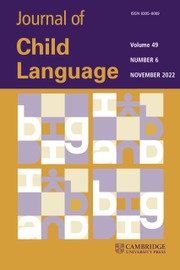Crossref Citations
This article has been cited by the following publications. This list is generated based on data provided by
Crossref.
Wilson, W. R.
and
Morton, K.
1990.
Reconsideration of the action-theory perspective on speech motor control.
Clinical Linguistics & Phonetics,
Vol. 4,
Issue. 4,
p.
341.
Bloom, Kathleen
1990.
The Development of attention - Research and Theory.
Vol. 69,
Issue. ,
p.
121.
Locke, John L.
1992.
Thirty years of research on developmental neurolinguistics.
Pediatric Neurology,
Vol. 8,
Issue. 4,
p.
245.
Locke, John L.
1992.
Neural specializations for language: a developmental perspective.
Seminars in Neuroscience,
Vol. 4,
Issue. 6,
p.
425.
Tanguay, Peter E.
1992.
The Mosaic of Contemporary Psychiatry in Perspective.
p.
392.
Locke, John L.
1993.
Developmental Neurocognition: Speech and Face Processing in the First Year of Life.
p.
317.
Nwokah, Evangeline E.
Hsu, Hui-Chin
Dobrowolska, Olga
and
Fogel, Alan
1994.
The development of laughter in mother-infant communication: Timing parameters and temporal sequences.
Infant Behavior and Development,
Vol. 17,
Issue. 1,
p.
23.
Locke, John L.
1994.
Gradual Emergence of Developmental Language Disorders.
Journal of Speech, Language, and Hearing Research,
Vol. 37,
Issue. 3,
p.
608.
Elias, Gordon
and
Broerse, Jack
1995.
Temporal patterning of vocal behaviour in mother-infant engagements: Infant-initiated “encounters” as units of analysis.
Australian Journal of Psychology,
Vol. 47,
Issue. 1,
p.
47.
Locke, John L.
1995.
Current Topics in Primate Vocal Communication.
p.
253.
1996.
The Handbook of Child Language.
p.
691.
Locke, John L.
1996.
Why do infants begin to talk? Language as an unintended consequence.
Journal of Child Language,
Vol. 23,
Issue. 2,
p.
251.
Elias, Gordon
and
Broerse, Jack
1996.
Developmental changes in the incidence and likelihood of simultaneous talk during the first two years: a question of function.
Journal of Child Language,
Vol. 23,
Issue. 1,
p.
201.
Locke, John L.
1997.
A Theory of Neurolinguistic Development.
Brain and Language,
Vol. 58,
Issue. 2,
p.
265.
Bacri, Nicole
1997.
Garçons et filles, hommes et femmes.
p.
53.
Veneziano, Edy
2000.
L'acquisition du langage. Volume I.
p.
231.
Hadders-Algra, M.
and
Dirks, T.
2000.
De motorische ontwikkeling van de zuigeling.
p.
81.
Hsu, Hui‐Chin
and
Fogel, Alan
2001.
Infant Vocal Development in a Dynamic Mother‐Infant Communication System.
Infancy,
Vol. 2,
Issue. 1,
p.
87.
Hsu, Hui-Chin
Fogel, Alan
and
Messinger, Daniel S
2001.
Infant non-distress vocalization during mother-infant face-to-face interaction: Factors associated with quantitative and qualitative differences☆ 7 7☆ This research was supported by faculty research grants to Hui-Chin Hsu from the College of Family and Consumer Science, the University of Georgia, and the University of Georgia Research Foundation, and by grants to Alan Fogel from the National Institutes of Health (R01 HD21036), the National Institute of Mental Health (R01 MH48680 and MH57669), and the National Science Foundation (BN9006756). Portions of the data were presented at the International Conference on Infant Studies, April 1998, and the Human Development Conference, April 2000. The authors thank the mothers and infants who participated in the study, and the research assistants who helped with the project..
Infant Behavior and Development,
Vol. 24,
Issue. 1,
p.
107.
Nathani, Suneeti
and
Oller, D. Kimbrough
2001.
Beyond ba-ba and gu-gu: Challenges and strategies in coding infant vocalizations.
Behavior Research Methods, Instruments, & Computers,
Vol. 33,
Issue. 3,
p.
321.

